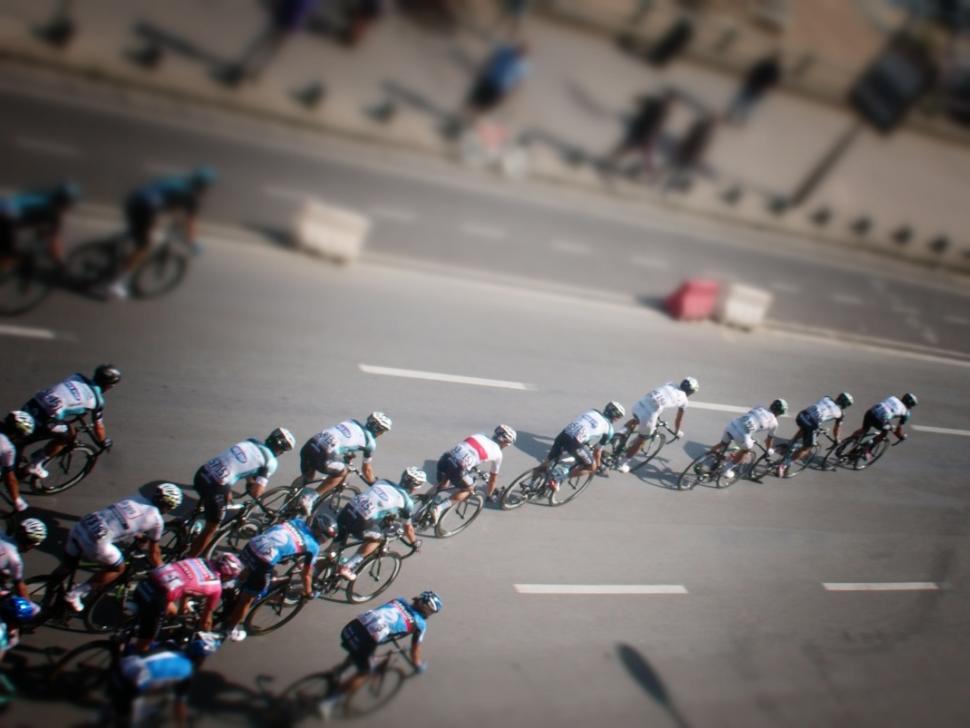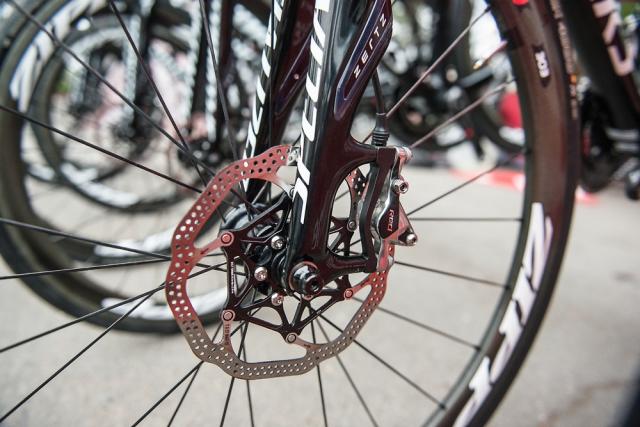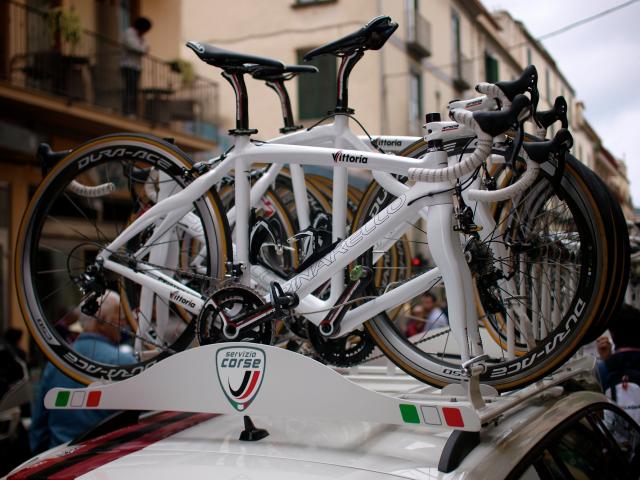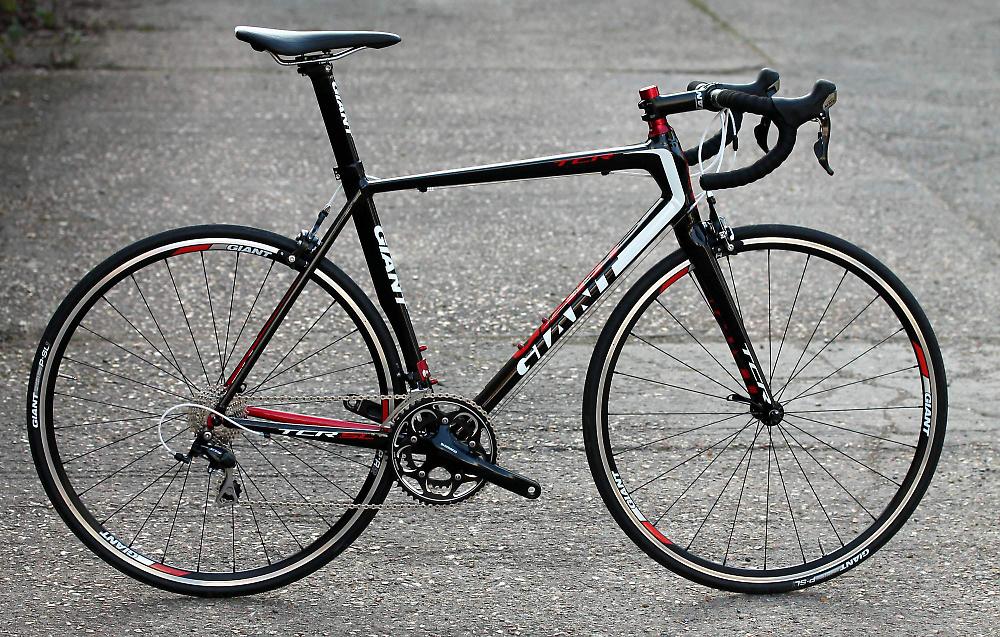- News
- Reviews
- Bikes
- Components
- Bar tape & grips
- Bottom brackets
- Brake & gear cables
- Brake & STI levers
- Brake pads & spares
- Brakes
- Cassettes & freewheels
- Chains
- Chainsets & chainrings
- Derailleurs - front
- Derailleurs - rear
- Forks
- Gear levers & shifters
- Groupsets
- Handlebars & extensions
- Headsets
- Hubs
- Inner tubes
- Pedals
- Quick releases & skewers
- Saddles
- Seatposts
- Stems
- Wheels
- Tyres
- Tubeless valves
- Accessories
- Accessories - misc
- Computer mounts
- Bags
- Bar ends
- Bike bags & cases
- Bottle cages
- Bottles
- Cameras
- Car racks
- Child seats
- Computers
- Glasses
- GPS units
- Helmets
- Lights - front
- Lights - rear
- Lights - sets
- Locks
- Mirrors
- Mudguards
- Racks
- Pumps & CO2 inflators
- Puncture kits
- Reflectives
- Smart watches
- Stands and racks
- Trailers
- Clothing
- Health, fitness and nutrition
- Tools and workshop
- Miscellaneous
- Buyers Guides
- Features
- Forum
- Recommends
- Podcast
TECH NEWS
 Giro Napoli copyright Simon MacMichael 006
Giro Napoli copyright Simon MacMichael 006Which UCI technical rules should be updated? We asked the experts
The bikes the professionals use are about to change radically... Well, they are if a lot of the bike industry's most influential companies have anything to do with it. And if the bikes the professionals use change, the bikes the rest of us ride will alter soon afterwards.
Your next bike could be dramatically lighter, faster, and more comfortable than your current one, if the bike industry gets its way. In fact, from what the people we've talked to have been saying it would seem your current bike would be a lot better than it is if it wasn't for those UCI tech regs.That applies whether you race or not, and pretty much irrespective of your bike's price tag too. It even has an effect beyond the performance bike category. What the pros ride makes a difference.
Okay, let's start at the beginning. Why might the pros' bikes be about to change? Well, Brian Cookson’s election as president of the UCI (Union Cycliste Internationale, cycle racing’s world governing body) last month has ushered in a period of potential change in cycling.
.jpg)
It's not just on doping that Cookson is facing pressure to take far-reaching action. Many of cycling's biggest brands have long been frustrated by the UCI's technical rules, feeling that the regulations are archaic and stifle innovation.
The rumblings of discontent have been getting ever louder lately, if our conversations at recent trade shows are anything to go by, and the bike industry has a whole lot of financial muscle. In terms of revenue, it is the biggest sports goods industry in the world. When you have people like Giant, Canyon and Storck (see below) saying that the UCI's minimum weight limit for bikes is outdated, for example, you have to think that the rule is going to be changed eventually, and that time be fast approaching.
The rules
The UCI's equipment rules are set out in Chapter 3 of the UCI Cycling Regulations, and that 6.8kg rule is perhaps the best known. The regulations also cover bicycle shape, tube dimensions, rider position, and so on.
The UCI amend and clarify the rules from time to time, but many date back to the Lugano Charter of 1996. At that time, the UCI Management Committee said, “The UCI wishes to recall that the real meaning of cycle sport is to bring riders together to compete on an equal footing and thereby decide which of them is physically the best… If we forget that the technology used is subordinate to the project itself, and not the reverse, we cross the line beyond which technology takes hold of the system and seeks to impose its own logic.”
Essentially, they were concerned that technical innovation meant that, “The performance achieved depends more on the form of the man-machine ensemble than the physical qualities of the rider, and this goes against the very meaning of cycle sport.”
The result was a set of equipment recommendations that were eventually ratified in 2000.
 The biggest change on the technical side of the sport since then has been the UCI’s introduction of their approval procedure for frames and forks at the start of 2011. Rather than having individual race commissionaires determine the legality of any frame and fork at a UCI accredited event, each brand now has to have their frames approved in advance by the UCI.
The biggest change on the technical side of the sport since then has been the UCI’s introduction of their approval procedure for frames and forks at the start of 2011. Rather than having individual race commissionaires determine the legality of any frame and fork at a UCI accredited event, each brand now has to have their frames approved in advance by the UCI.
Wheels for massed start events on the road and in cyclocross need prior approval too. In order to gain that approval, wheels must pass a rupture test in a UCI-approved laboratory. The UCI has also signaled its intention to extend its approval processes to other equipment over time.
Time for change?
So, what’s wrong with the rules? Well, there’s an argument that technology has overtaken the UCI regulations. Every manufacturer can now easily produce bikes that weigh well under 6.8kg without compromising safety (not that the weight necessarily corresponds to safety anyway), so aren’t the rules just holding back innovation or, at the very least, not reflecting modern capabilities?

Also, big manufacturers like SRAM and Shimano have come out with major new disc brake designs recently, and Campagnolo will follow suit soon. They’re currently not allowed in UCI accredited races on the road; should they be?
We decided to ask leading figures in the bike industry what they thought should be done now that there seems to be a new mood of change at the UCI (maybe). Many didn’t want to make suggestions. Fair enough. This reply from Alex Wassmann, SRAM's Road-Tri-CX Sport Marketing Manager, is representative of several…
“SRAM is a member of the WFSGI (World Federation of Sporting Goods Industry). This organisation is the officially recognised cycling industry representative body by the UCI/IOC [International Olympic Committee]. WFSGI voices the interests of manufacturers whose products are raced in UCI events.
"Through WFSGI we and other voluntary industry members are engaged in an ongoing dialogue with the UCI regarding their existing and potential cycling technology regulations and policies. We and the other members naturally also seek expansion in interpretation, modifications or additions in the UCI regulation's as relevant bike tech marches forward and as road sport as it is interpreted by the UCI/IOC changes.
"After several years of activity WFSGI has developed a confident voice on behalf of its members and our varied interests. Therefore we think the WFSGI is the best to answer in detail your question.”
That's reasonable. So, we did indeed ask the WFSGI (see below). Here are all the responses we received to the question ‘Which UCI technical rules should be updated, and why?’
The words “rules/regulation” are never ideal for our industry. It is tightening our hands when it comes to innovations even when we know that in certain cases it is inevitable that rules/regulations have to be made.
In the case of the UCI we struggle with the fact that the know how of the UCI technical staff on bicycle products is very limited and therefore there is a big gap in understanding to our industry on the technical challenges.
Our industry has many years of experience in product development and we can support the UCI in many ways when it comes to rules/regulations for products but we shall not live in the past. Therefore we need to come to a point with the UCI where product innovation can contribute to make racing more attractive and healthier for the riders, spectators and the television viewers.
We should not forget that “innovation is sales” and “sales” mean “investment in the sport”. If this doesn’t work, brands have increasingly difficulties to continue to invest in professional racing. Today, the amateur riders can use better and more high tech products then the professional riders and this is quite a “special” situation and probably the only sport where this happens. We are looking forward to further discuss with President Cookson to better catch his views on our industry issues.
Note that we will soon have further discussion with the UCI on the next steps. We have open issues on wheel and technical rules where we shall understand the way forward.
Robbert De Kock, Secretary General, World Federation of Sporting Goods Industry
From our perspective what we would like to see changed are the following:
1. Weight minimum. We can easily hit weights well below the current minimum and pass all CE testing. The weight minimum has hindered what we can do from a manufacturing standpoint and the product in the pro peloton is not truly indicative of what we, Giant, can actually do if we were to have free rein.
2. Double diamond design. I'm not saying we would immediately abandon the current design but we'd like the option to explore a bit more.
Outside of this it can just get nitpicky. Overall we want to provide our athletes with the best product possible and with the current and clearly outdated rules we cannot deliver what we are truly capable of.
Jon Swanson, Global Category Manager for On-Road product, Giant
We all sit in the same boat and have to see that we push forward the sport of cycling together. We only can be successful together.
To reach this goal, I wish for a closer and more intensive communication between the manufacturers and the UCI. Everybody should understand and respect the needs and requirements of others. For the UCI, the main targets should be to take care of the safety of the rider and to prevent any unfair advantage coming from the material.

Topics where I see a need for discussion:
6.8kg rule: I think it is already proven that it is possible to produce safe bicycles under 6.8kg.
Seating position time trial: A lot of riders are not able to sit ergonomic on the bike with the current restrictions.
Braking system: Finally, the UCI should allow the best and safest brake system for the rider.
Of course, the shape and cross section rules are also a huge limitation for the design, and they should also be discussed.
Michael Kaiser, Director of Engineering, Canyon Bicycles
I have three points that UCI should change.
1. Weight limit. It does not make any technical sense to have a weight limit at all. Products do need to pass technical test such as stiffness, maximum loads, and lifecycle test. Storck works with EFBE lab and EFBE Testing machines [bicycle test specialists] and we feel that those tests are optimum to guarantee safety to the riders. If a frame is passing these test then there is no need to have any other testing. Our bikes are passing these test and the weight of some models is 5.5 kg or even lighter. UCI is not allowing innovation.
2. UCI sticker. The UCI is asking the manufactures to send them the drawings from a frameset and then to pay a fee. This has no other reason thea having a cash cow, by looking on a drawing you cannot check any quality and it is not safety for the rider at all. UCI must change this and they can check at a race that the frame is keeping the dimensions they request.
3. UCI should make disc brakes legal and there must be tests that frames and forks must pass in order to be allowed.
Markus Storck, founder and CEO, Storck Bicycles
Liberalising the world of road bikes could have a positive effect, but only on the condition that if the rules are relaxed, they must continue to be managed in is strict framework to avoid going out of control. In order to do this there is only one solution: gathering together all the major players for a round table.
Gilles Lapierre, Managing Director, Cycles Lapierre
The biggest rule that needs a change is the UCI wheel rupture test, or impact test. This is something that we have been working with other industry brands to suggest realistic standards to the UCI through the World Federation of Sporting Good Industry wheel committee.

We would like to see real world load and a test procedure that can be conducted by multiple labs with clear pass/fail criteria. This will ensure rider safety while allowing innovation.
Adam Marriott, Product Manager, Easton Cycling
There are many areas where we need to think about a change of the regulations because these regulations were made over 13-14 years ago, where the bikes and the material used at that time were very different from what we are using today.
For this reason, the bikes and components in the last years have made tremendous evolution, thanks to the use of composite and the know how that has been made by the industry. Thanks to this, we suppose that the rules and the limitation need to follow the evolutions.
The areas to work on are:
- Make sure all the bikes and components are able to accomplish the CEN rules, not just by the weight limitation.
- Disc brake for road bike.
- Improve the rules and the protocol to approve the wheels that can be used for racing.
Claudio Marra, General Manager, FSA Europe
Road: The market requests very comfortable tyres, which could prevent any impact, if they have more volume. The current rule restricts the use to a certain volume (diameter). Let’s rethink this rule to provide better performing tyres.

Off-road: The only thing that has come up recently, was that if a rider raced a non-UCI event, then they might have their license revoked. This clearly does not promote racing as a whole, and is greedy on the part of UCI. This is especially relevant for Enduro, due to the World Enduro Series that was recently created.
Malte Stampe, Director of Global Marketing and Communication of the Vittoria Group (Vittoria tyres, Geax tyres)
First of all, congratulations to the new President. Our hope is that he will give more space to tech innovations on road racing bikes. Of course, in full safety. I mean; innovation should never compromise the safety of the athlete.
For example, a good thing could be allowing disc brakes on road racing bikes. Bicycles’ technical innovation and progress cannot be stopped, particularly when it is devoted to better the bike performance and the athletes’ safety.

Vittorio Fontana, Olympia Group owner (Olympia bikes, Scapin bikes, Frera)
Brakes: The first change I’d like to see on road racing bikes is disc brakes, say making them legal from 2016, so everyone has time to adapt. Disc brakes are safer because they offer far better modulation (power without lockup) and the rims do not undergo brake pad damages. The fear of peloton accidents due to different braking power is baseless. The brakes used today all have different power anyway due to different designs and materials.
Bars: The 3:1 rule [tube depth must not exceed three times the width] could pass to 4:1 and then 5:1 over the years, to promote some changes.
Wheels: Wheels as well could benefit from more design freedom. There’s plenty to be done there. Of course, always progressively, to avoid sudden radical changes.
More generally, I think UCI should let more innovation go into bikes, wheels and parts, so the whole industry could grow and offer more support to the sport.

Simone Roncali, Director Product Development, 3T Cycling
CamelBak has been working closely and always had great understanding and responsiveness from UCI when it comes to approval and adoption of innovative products. The Racebak underwear (underwear with integrated reservoir for drinking while riding) has been around for a while and many riders from different team (regardless of sponsorship obligations) asked CamelBak to use it and indeed they used it.
UCI doesn't oppose the use of the RaceBak but is limiting the size of the reservoir to 0.5L. For this reason we would suggest elevating this limit to at least 1L, considering that in some racing condition (length and duration of a stage) and weather conditions (hot temperature days) the 0.5L reserve may not suffice to keep the rider properly hydrated.
On another subject: UCI has recently introduced the green zones at the Grand Tours; these are specific areas along the route where riders should discard empty bottles (which are then collected by the race organisation) and therefore should contribute to a more green and less polluting behaviour of the riders during the race. This environmentally friendly and sustainable initiative should be patrolled and UCI should, if not give a fine to those riders throwing away bottles outside the designated areas, possibly give some bonus to those riders/teams who are behaving according to the new rules.

Massimo Fregones, Director, International Sales & Marketing, CamelBak International
De Marchi has been making racing wear for the world’s top riders for over 60 years, clothing world champions and tour winners. We have seen a lot of changes in the sport of cycling in that time and are hoping that the recent changes will bring stability and harmony to the sport we love.
Up until this point, the UCI has not imposed many rules regarding clothing design and at De Marchi we are hoping it remains that way. Too much regulation will limit innovation and we totally support the fact that racing innovation be available to everyday cyclists.
Mauro Coccia, De Marchi owner
So, what do you think? Have these industry figures got it right, or are we happy with things the way they are? Let us know your views...
Mat has been in cycling media since 1996, on titles including BikeRadar, Total Bike, Total Mountain Bike, What Mountain Bike and Mountain Biking UK, and he has been editor of 220 Triathlon and Cycling Plus. Mat has been road.cc technical editor for over a decade, testing bikes, fettling the latest kit, and trying out the most up-to-the-minute clothing. He has won his category in Ironman UK 70.3 and finished on the podium in both marathons he has run. Mat is a Cambridge graduate who did a post-grad in magazine journalism, and he is a winner of the Cycling Media Award for Specialist Online Writer. Now over 50, he's riding road and gravel bikes most days for fun and fitness rather than training for competitions.
Latest Comments
- bikeman01 42 min 47 sec ago
Why do you think it was filmed by his dad? The article doesnt say that.
- ridein 1 hour 55 min ago
I wonder if you could use a Northwave shoe (w/Speedplay drilling) on the Ekoi pedal. Possibly using one Look pattern cleat hole and two Speedplay...
- Surreyrider 3 hours 38 min ago
I've worked in local government before and some really don't need any training for that - they're already masters!
- Rendel Harris 7 hours 35 min ago
They have here: results at 14.40. The aero bike was roughly fifteen seconds faster than a climbing bike on a descent of around 6 km, so about 3km/h...
- wtjs 7 hours 49 min ago
As I've also placed here the nutter Audi and white van drivers, I've decided to give those no-nonsense keep-the-country-moving BMW drivers a list...
- polainm 8 hours 52 min ago
100% this. Policing mentality is formed by social 'norms', and the cyclist witchhunting across social media is the UK norm. Close passing a person...
- David9694 10 hours 17 min ago
That's a clear 2 points awarded there, but I guess as there's now a 25% tariff you'll only get 1.5
- mark1a 10 hours 28 min ago
Fawkes Cycles is only local if you live near Oldham. That's nearly 300 miles away from me. Also, any retailer that doesn't participate in an...
- David9694 10 hours 30 min ago
Openreach under fire over delays to Amesbury cabinet repairs...
- Destroyer666 18 hours 28 min ago
Anodizing the aluminium is also for corrosion resistance and therefore enhances the longevity of the rims while this is not really a case for...


Add new comment
43 comments
The thing that I worry about is cycling becoming an "arms race" if changes to equipment are made too quickly or if radical new and better designs are allowed.
I'm sure that we all know that bikes and equipment really do make a difference to a riders performance so if we're not careful cycling will no longer be a pure battle of athlete against athlete. Instead, the rider or team with the biggest budget and access to the best, ground breaking equipment will have a huge advantage akin to what we are seeing in F1.
In the above scenario how would a developing rider ever progress if he/she couldn't compete on a level playing field. The margin of performance that different bicycle and equipment designs could offer the rider could possibly be greater than any act of doping. Seeing this product development that is too quick or isn't widely available would just be a form of "legal, equipment doping"
In the UK we are already seeing this to a certain extent within the time trialling scene. Riders who have larger personal budgets (and fair play to them for working hard in their life for a good income) are competing on bikes that are literally multiple thousands of pounds of aero refinement. Coupled with the wind tunnel tuned riding position that works perfectly with their bicycle, helmet and skin suit they instantly have a huge advantage over a rider who doesn't have the funds for this level of equipment and technical refinement.
I'm all for technical innovation and love new ideas and equipment but I hope that the "new UCI" is sensible with any changes so that riders of all levels can compete on a level a playing field as possible. This way, hopefully, the strongest rider will always win.
The strongest riders always win anyway.If you think time trial riders riding top tt bikes aero suites helmet etc would beat Brad wiggins on a standard road bike normal helmet etc your wrong.
The people harping on about the 6.8 kg weight limit like it's some kind of albatross are only interested in $$$. They can already make bikes lighter than that but, apart from massaging the egos of well-heeled MAMILs and weenies, what is the point?
There will be no improvement in the quality of racing at any level. If a team has to add weights to the bike to make it 'legal' that's their (and the frame manufacturer's) choice.
At a time when teams and events are disappearing at all levels due to lack of sponsors what would it achieve?
I think disc brakes are a great idea but there are practical issues to be ironed out before they are adopted for racing.
But is the RaceBak really where some in the industry thinks the effort should go? I'm not against them per se but I hear the sound of a barrel being scraped. I'd be keener to see feed zones, as they currently operate, to end. From what I've seen they appear to be one of the most dangerous parts of any race.
Nope - the RaceBak is where the bloke from CamelBak thinks the effort should go. Odd that
Well, that works, to some extent, for time trialling. In road racing, it's rarely the strongest rider who wins, especially higher up the ranks. Strength, tactics, allegiances, equipment - they all contribute to the beautiful uncertainty of a bike race - and that's what makes it fun. It's the balance between all that that has to be maintained - so I agree that the UCI shouldn't let technical advantages win out, but it would be nice to add a few more technical variables to the pot.
Innovation leads to paths we have yet to explore. Why not let some private bike companies (or blokes in sheds) go and explore what is possible. They still have to fit the basic bike shape, but when I look at the Lotus and the stuff that Mr Obree was doing, have we actually gone forward that much?
Great article. I'm certainly excited about the potential for the trickle down tech that comes from scope to innovate - and I wouldn't mind an industry change to work on the engineering side!
Let the cost of top end road bikes spiral out of control. The average cost of an entry bike won't increase it will just use less features of the top end road bikes. However, over time those features will trickle down the price points and increase the quality and features of all road bikes.
Furthermore dropping the weight and 3:1 limits won't necessarily lead to huge increases in bike cost. The specialized Shiv doesn't follow the 3:1 rule but is within the realm of standard pricing for a top end triathlon bike
Question is though, if SOME riders have access to far superior equipment is that an unfair advantage? i.e. Take the Eritrean cycling federation, are they in the same position as British Cycling when it comes to supplying kit to riders. Are we risking loosing good riders because they are not able to compete on a level playing field? Is that a good thing?
I interpreted it to mean keep the costs down for UCI entry level racers, who are generally poorer than amateurs buying entry level bicycles.
Whilst I agree with the comments about bikes being under the weight limit yet exceeding the safety standards. I always thought the idea was to stop the cost factor spiralling out of control. (Same reason of the double diamond and 3:1 rule.) For this reason alone I'd like to see the weight limit kept.
Likewise with discs, as discussed in other threads what would be the cost of neutral service cars carrying several wheels of different axle lengths, with/out discs, Shimano/Campag? Eventaully it will happen, but let's wait until the majority of bikes are disc shod before leaping that way.
As for the comment about amateurs riding better bikes, bog standard drivers have ABS, EPS, traction contol, parking asissistance and so on, whilst F1 drivers don't!
Yes but only because the national socialists sorry FIA have banned them. Can see cycling going like formula 1 if the rules are relaxed too much and we will have 1 team/ rider winning everything.
Why not just have position rules for the bottom bracket, saddle and handlebars so they can't ride recumbent and have no limit to whats in between. Lets have bikes like the Lotus 108 and Zipp 2001 manufacturing methods would also help us all get cheaper better bikes.
Of I still wish velomobiles were widely used, an ordinary person being able to cruise along at 25mph would make cycle commuting much more viable.
Pages